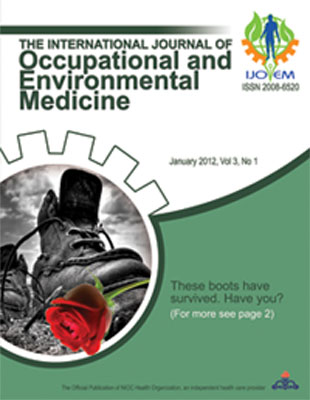فهرست مطالب

International Journal of Occupational and Environmental Medicine
Volume:3 Issue: 1, Jan 2012
- تاریخ انتشار: 1390/10/26
- تعداد عناوین: 9
-
-
Page 2Unexpected extreme sudden traumatic stressor may cause post-traumatic stress disorder (PTSD). Important traumatic events include war, violent personal assault (e.g., sexual assault, and physical attack), being taken hostage or kidnapped, confinement as a prisoner of war, torture, terrorist attack, severe car accidents, and natural disasters. In childhood age sexual abuse or witnessing serious injuries or unexpected death of a beloved one are among important traumatic events.PTSD can be categorized into two types of acute and chronic PTSD: if symptoms persist for less than three months, it is termed “acute PTSD,” otherwise, it is called “chronic PTSD.” 60.7% of men and 51.2% of women would experience at least one potentially traumatic event in their lifetime. The lifetime prevalence of PTSD is significantly higher in women than men. Lifetime prevalence of PTSD varies from 0.3% in China to 6.1% in New Zealand. The prevalence of PTSD in crime victims are between 19% and 75%; rates as high as 80% have been reported following rape. The prevalence of PTSD among direct victims of disasters was reported to be 30%–40%; the rate in rescue workers was 10%–20%. The prevalence of PTSD among police, fire, and emergency service workers ranged from 6%–32%. An overall prevalence rate of 4% for the general population, the rate in rescue/recovery occupations ranged from 5% to 32%, with the highest rate reported in search and rescue personnel (25%), firefighters (21%), and workers with no prior training for facing disaster. War is one of the most intense stressors known to man. Armed forces have a higher prevalence of depression, anxiety disorders, alcohol abuse and PTSD. High-risk children who have been abused or experienced natural disasters may have an even higher prevalence of PTSD than adults.Female gender, previous psychiatric problem, intensity and nature of exposure to the traumatic event, and lack of social support are known risk factors for work-related PTSD. Working with severely ill patients, journalists and their families, and audiences who witness serious trauma and war at higher risk of PTSD.The intensity of trauma, pre-trauma demographic variables, neuroticism and temperament traits are the best predictors of the severity of PTSD symptoms. About 84% of those suffering from PTSD may have comorbid conditions including alcohol or drug abuse; feeling shame, despair and hopeless; physical symptoms; employment problems; divorce; and violence which make life harder. PTSD may contribute to the development of many other disorders such as anxiety disorders, major depressive disorder, substance abuse/dependency disorders, alcohol abuse/dependence, conduct disorder, and mania. It causes serious problems, thus its early diagnosis and appropriate treatment are of paramount importance.
-
Page 10BackgroundContact dermatitis (CD) is a significant problem among nurses. Although there are reports about the prevalence of CD from different parts of the world, data about its frequency in Turkey and about allergic contact sensitization among nurses is insufficient.ObjectiveTo define the frequency and patterns of allergic contact sensitization and related symptoms in practicing and student nurses.MethodsThere were 123 nurses in our hospital practicing in the in-patient clinics. All were invited to participate in the study. 69 working-in nurses and 79 student nurses participated in the study. The main reason for refusal of nurses was that they were usually having a shower daily after a hard working day and they had to postpone having a bath for 3 days if they had a patch test on their back. A ready-to-use patch test system (TRUE test®) with 29 standardized test substances was applied to all of the participants. History about symptoms of CD and allergic diseases was investigated by questionnaire.ResultsWhile 34.8% (24/69) of practicing nurses had symptoms of CD, 19% (15/79) of student nurses reported the symptoms (p=0.039). The most prevalent positive reaction was to nickel sulfate followed by thimerosal. There was no difference for positive reaction rates between practicing and student nurses. Nurses who had symptoms of CD were older than those without symptoms (p=0.003). The participants with symptoms of CD were more frequently from practicing nurses (p=0.047).ConclusionCD is more frequent in practicing nurses than student nurses; allergic contact sensitization is not. This may be attributed to the length of occupation that is also correlated well with the length of exposure to the occupational irritants.
-
Page 19BackgroundIn our competing educational world, students spend a considerable part of their daily life, studying at library furniture. Not surprisingly, due to lack of proper anthropometric databases, these products have typically been ill fitted for the intended user populations.ObjectiveTo verify the optimum anthropometric match of library furniture within an academic environment, through a combined qualitative and quantitative approach.Methods267 (120 female and 147 male) students, were subjected to 11 standard anthropometric measurements. In line with the measurements, subjective evaluations were also considered through detailed fitting trials on selected groups of participants.ResultsCombinational equations defined the unacceptable furniture dimensions according to elbow and sitting popliteal heights, mainly for smaller and taller divisions of the studied population, which were systematically comparable along with subjective and objective outcomes. In brief, if we classified studied students into “small,” “medium,” and “tall” groups, the design dimensions should be altered by -5.1, -2.2, and +1.6 cm for chair seat height; and by -8.3, -5.4, and +1.1 cm for table height, for each student group, respectively.ConclusionThe furniture size to be used by Iranian students should be changed to fit their anthropometric measures.
-
Page 27BackgroundThe environmental degradation products of pesticides may enter drinking water and result in serious health problems.ObjectiveTo evaluate the occurrence of insecticides in drinking surface and ground water in Dakahlyia Governorate, northern Egypt in 2011.MethodsWe studied blood samples collected from 36 consecutive patients diagnosed with pesticides poisoning and 36 tap drinking water (surface and ground). Blood and water samples were analyzed for pesticides using gas chromatography-electron captured detector (GC-ECD). In addition, blood samples were analyzed for plasma pseudo-cholinesterase level (PChE) and red blood cells acetyl cholinesterase activity (AChE).ResultsThe results confirmed the presence of high concentrations of insecticides, including organonitrogenous and organochlorine in tap drinking surface and ground water.ConclusionDrinking water contaminated with insecticides constitutes an important health concern in Dakahlyia governorate, Egypt.
-
Page 33BackgroundThe effect of health status on productivity has widely been studied and discussed in literature. Valid and reliable tools are needed to evaluate the levels of health and productivity and provide detailed information, before any intervention is implemented. World Health Organization Health and Work Performance Questionnaire (HPQ) is a widely used instrument in estimating the workplace costs of health problems in terms of reduced job performance, sickness absence, and work-related accidents and injuries.ObjectiveTo assess the reliability and validity of Persian version of HPQ in Iranian health care workers.MethodsThe questionnaire was translated to Persian and back translated. 102 health care workers completed the questionnaire. Absence and sick-leave data was extracted from administrative records.ResultsFactor analysis revealed acceptable validity for the questionnaire in part A (health). Cronbach's alpha was >0.73 for all scales of Parts B (work) and C (demographic). Questions targeting days of absence and sick-leave had acceptable correlation with administrative records (Pearson's r >0.75), while questions on total hours worked showed lower correlation.ConclusionPersian version of HPQ can be considered a reliable and valid tool in Iranian health workers
-
Page 39BackgroundBenzene, toluene, ethylbenzene and xylene (BTEX) are the most important toxic volatile compounds in the air and could be easily absorbed through the respiratory tract. In recent years, the risk of exposure to BTEX compounds, especially benzene as a carcinogen, has been considered in petroleum depot stations.ObjectiveTo assess the occupational exposure of petroleum depot workers in Iran to BTEX compounds.MethodsAfter completing a questionnaire and assessing occupational exposure to BTEX compounds, 78 (46 exposed and 32 non-exposed) depot workers were randomly selected to participate in this study. Air sampling and analysis of BTEX was conducted according to the NIOSH method No. 1501. Analysis of urinary hippuric acid, as an indicator of toluene exposure, was carried out according to NIOSH method No. 8300. Personal monitoring of the high exposure group to BTEX compounds was repeated to verify the results obtained in the first phase of the monitoring.ResultsAmong the 9 operating groups studied, occupational exposure to benzene and toluene was higher in quality control and gasoline loading operators—the median exposure ranged from 0.16 to 1.63 ppm for benzene and 0.2 to 2.72 ppm for toluene. Median exposure of other group members to BTEX compounds was below the detection limit of analytical method (0.07, 0.06, 0.05, and 0.05 ppm, respectively). The level of toluene exposure measured showed correlation with neither post-shift urinary hippuric acid (Spearman's rho=0.128, p=0.982) nor with the difference between post- and pre-shift urinary hippuric acid (Spearman's rho=0.089, p=0.847) in depot operational workers.ConclusionGasoline loading operators are exposed to a relatively high level of benzene
-
Page 51


